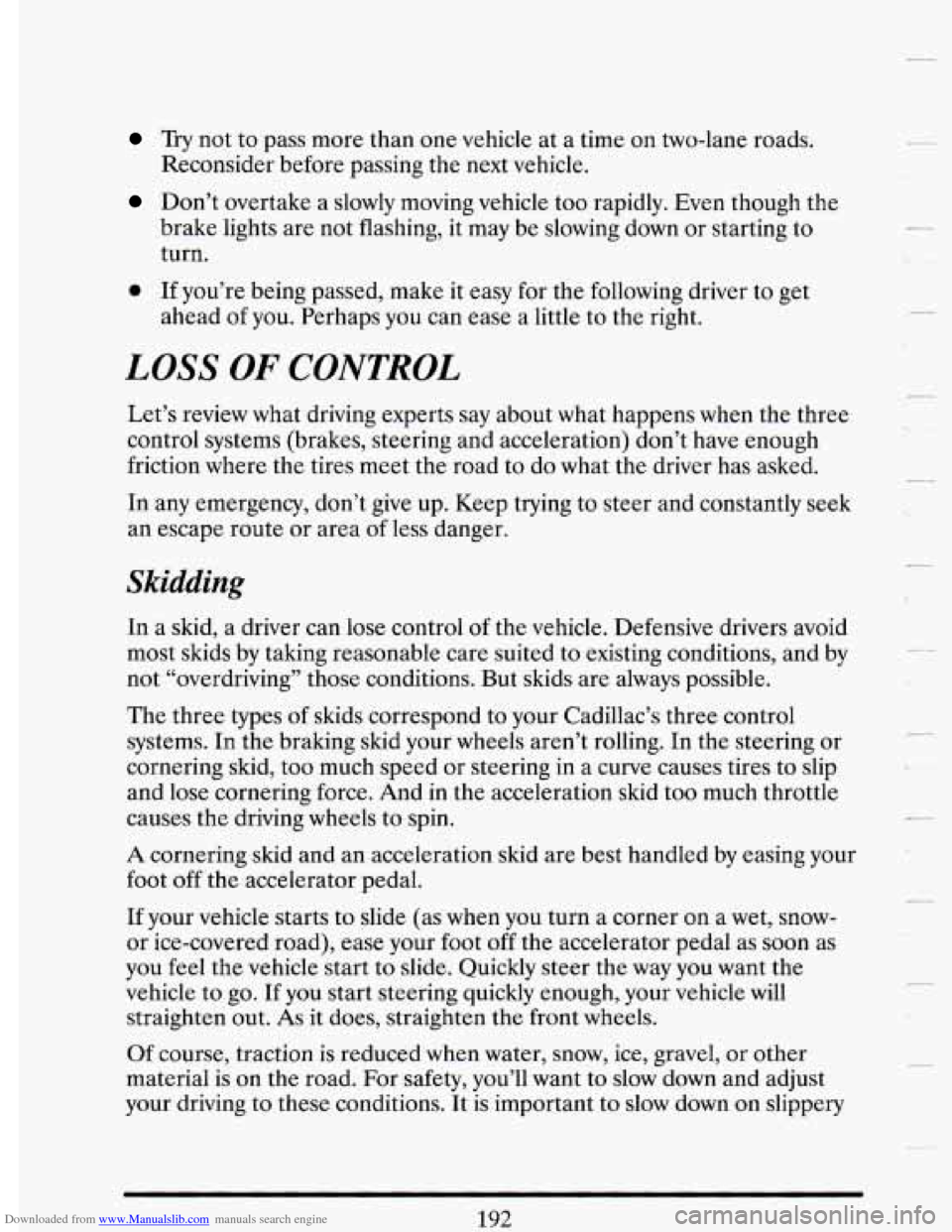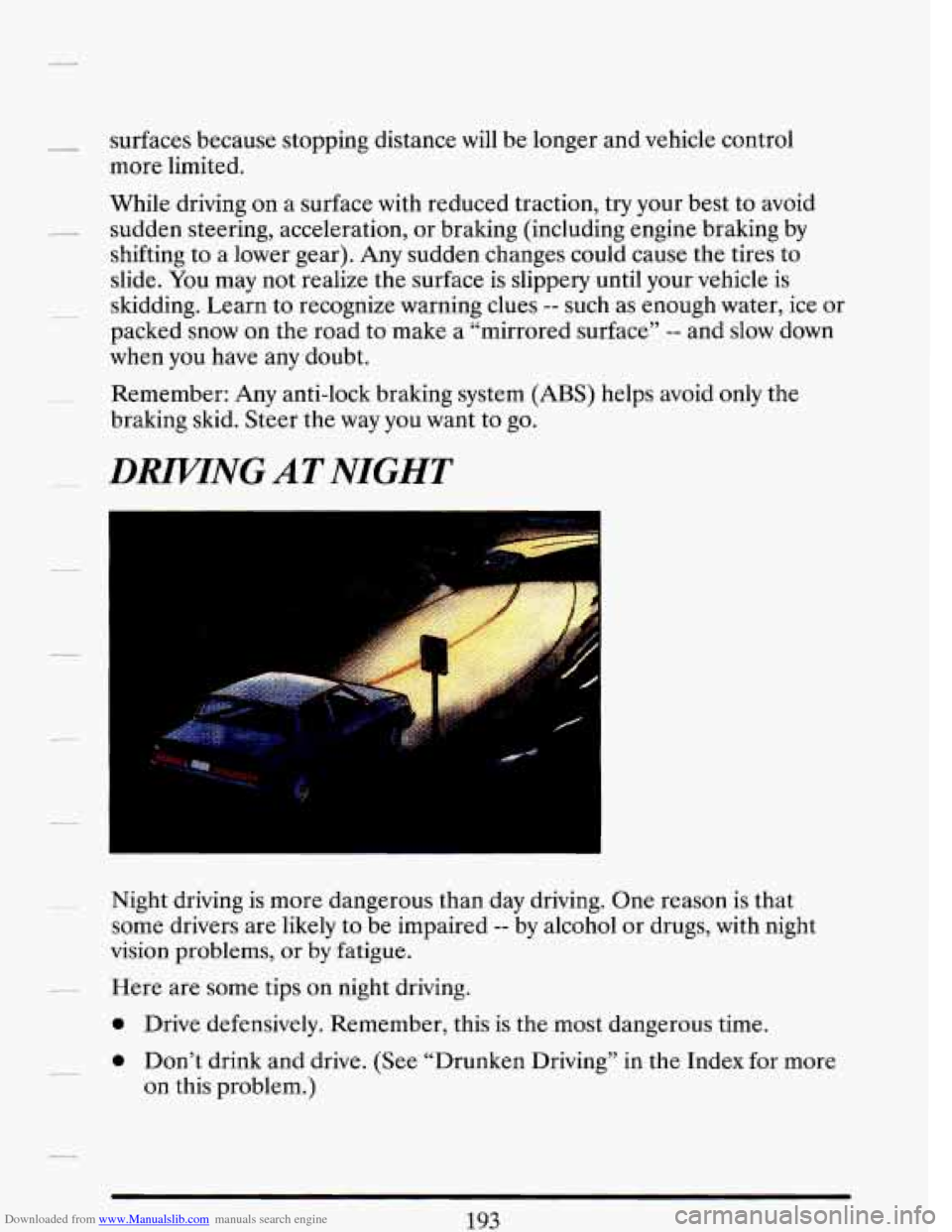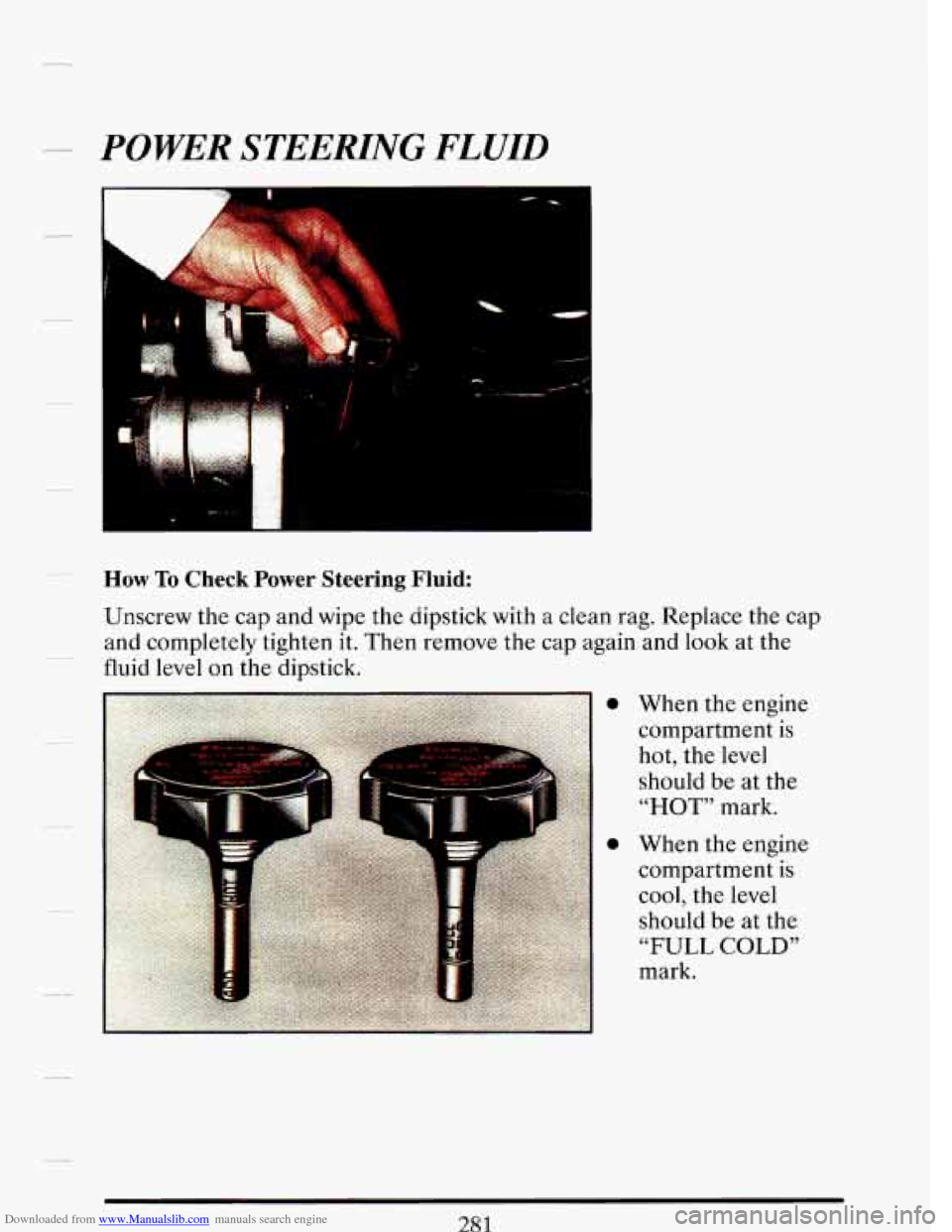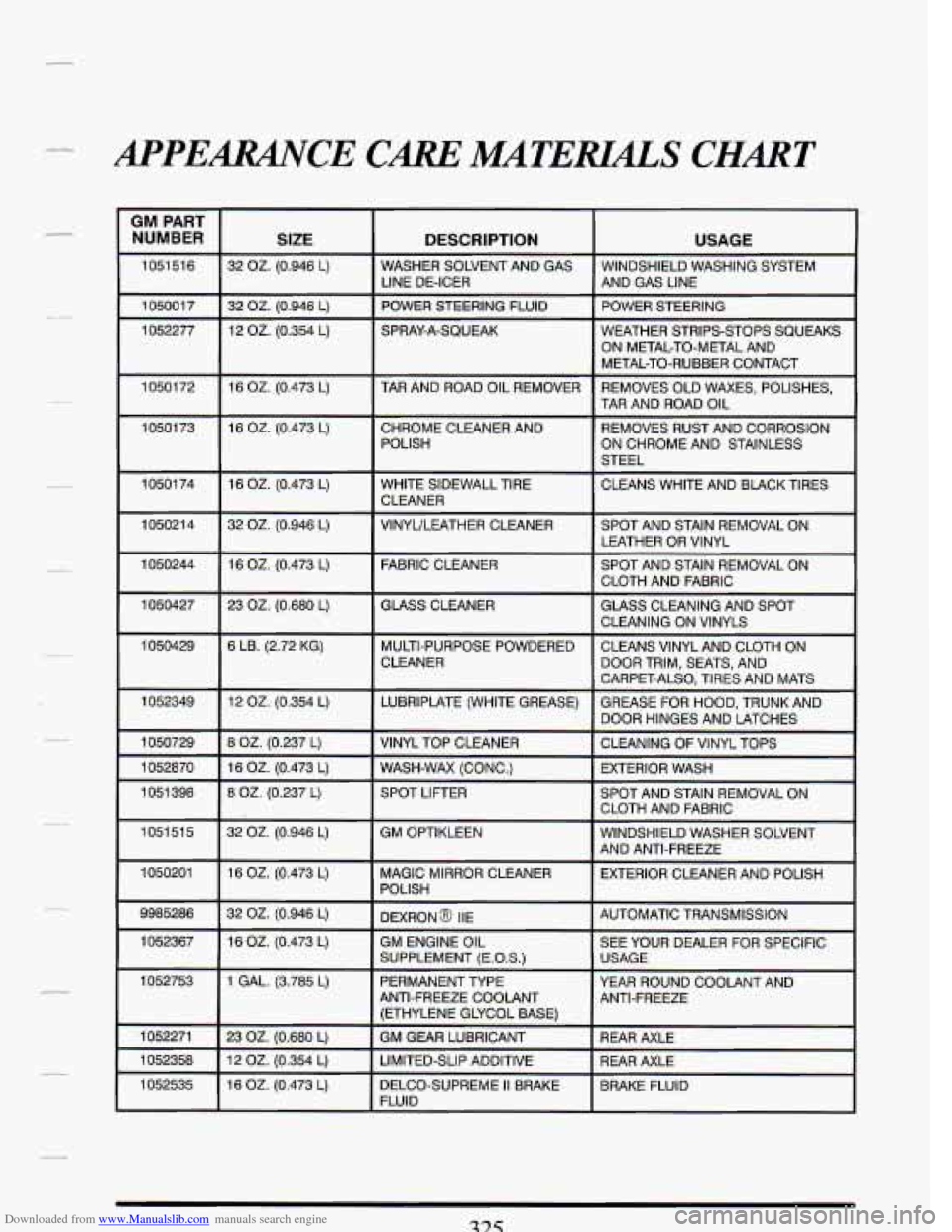steering CADILLAC DEVILLE 1993 7.G Owner's Manual
[x] Cancel search | Manufacturer: CADILLAC, Model Year: 1993, Model line: DEVILLE, Model: CADILLAC DEVILLE 1993 7.GPages: 406, PDF Size: 20.78 MB
Page 205 of 406

Downloaded from www.Manualslib.com manuals search engine Try not to pass more than one vehicle at a time on two-lane roads.
Reconsider before passing
the next vehicle.
Don’t overtake a slowly moving vehicle too rapidly. Even though the
brake lights are not flashing, it may be slowing down or starting to
turn.
0 If you’re being passed, make it easy for the following driver to get
ahead
of you. Perhaps you can ease a little to the right.
LOSS OF CONTROL
Let’s review what driving experts say about what happens when the three
control systems (brakes, steering and acceleration) don’t have enough
friction where the tires meet
the road to do what the driver has asked.
In any emergency, don’t give up. Keep trying to steer and constantly seek
an escape route or area
of less danger.
Skidding
In a skid, a driver can lose control of the vehicle. Defensive drivers avoid
most skids by taking reasonable care suited to existing conditions, and by
not “overdriving” those conditions. But skids are always possible.
The three types of skids correspond to your Cadillac’s three control
systems. In the braking skid your
wheels aren’t rolling. In the steering or
cornering skid, too much speed or steering
in a curve causes tires to slip
and lose cornering force. And in the acceleration skid too much throttle
causes the driving wheels to spin.
A cornering skid and an acceleration skid are best handled by easing your
foot off the accelerator pedal.
If your vehicle starts to slide (as when you turn
a corner on a wet, snow-
or ice-covered road), ease your foot off the accelerator pedal as
soon as
you feel the vehicle start to slide. Quickly steer the way you want the
vehicle to go. If you start steering quickly enough, your vehicle will
straighten out.
As it does, straighten the front wheels.
Of course, traction is reduced when water, snow, ice, gravel, or other
material is
on the road. For safety, you’ll want to slow down and adjust
your driving to these conditions. It is important
to slow down on slippery
192
Page 206 of 406

Downloaded from www.Manualslib.com manuals search engine surfaces because stopping distance will be longer and vehicle control
more limited.
While driving on a surface with reduced traction, try your best to avoid
sudden steering, acceleration, or braking (including engine braking by
shifting to
a lower gear). Any sudden changes could cause the tires to
slide. You may not realize the surface is slippery until your vehicle is
skidding. Learn to recognize warning clues
-- such as enough water, ice or
packed snow on the road to make a “mirrored surface”
-- and slow down
when you have any doubt.
Remember: Any anti-lock braking system
(ABS) helps avoid only the
braking skid. Steer the way you want to go.
DRIPTNG AT NIGHT
Night driving is more dangerous than day driving. One reason is that
some drivers are likely to be impaired
-- by alcohol or drugs, with night
vision problems, or
by fatigue.
Here are some tips on night driving.
0 Drive defensively. Remember, this is the most dangerous time.
0 Don’t drink and drive. (See “Drunken Driving” in the Index for more
on this problem.)
193
Page 228 of 406

Downloaded from www.Manualslib.com manuals search engine curve or an overpass may remain icy when the surrounding roads are
clear.
If you see a patch of ice ahead of you, brake before you are on
it.
Try not to brake while you're actually on the ice, and avoid sudden
steering maneuvers.
IfYou%e Caught in a Blizzard
r
If you are stopped by heavy snow, you could be in a serious situation. You
should probably stay with your vehicle unless you know for sure that you
are near help and
you can hike through the snow. Here are some things
to do to summon help and keep yourself and your passengers safe: Turn
on your hazard flashers. Tie a red cloth to your vehicle to alert police that
you've been stopped by the snow. Put on extra clothing
or wrap a blanket
around you.
If you have no blankets or extra clothing, make body
insulators from newspapers, burlap bags, rags, floor mats
-- anything you
can wrap around yourself or tuck under your clothing to keep warm.
You can run the engine to keep warm, but be careful.
Page 234 of 406

Downloaded from www.Manualslib.com manuals search engine electric brakes, start your vehicle and trailer moving and then apply the
trailer brake controller by hand to be sure the brakes are working. This
lets you check your electrical connection at the same time.
During your trip, check occasionally to be sure that the load is secure,
and that the lights and any trailer brakes are still working.
Following Distance
Stay at least twice as far behind the vehicle ahead as you would when
driving your vehicle without
a trailer. This can help you avoid situations
that require heavy braking and sudden turns.
Passing
You’ll need more passing distance up ahead when you’re towing a trailer.
And, because you’re a good deal longer, you’ll need to go much farther
beyond the passed vehicle before you can return to your lane.
Backing Up
Hold the bottom of the steering wheel with one hand. Then, to move the
trailer to the left, just move that hand to the left.
To move the trailer to
th.e right, move your hand to the right. Always back up slowly and,
if
possible, have someone guide you.
Making Turns
When you’re turning with a trailer, make wider turns than normal. Do
this so your trailer won’t strike soft shoulders, curbs, road signs, trees, or
other objects. Avoid jerky
or sudden maneuvers. Signal well in advance.
Turn Signals When Towing a Trailer
When you tow a trailer, your vehicle has to have a different turn signal
flasher and extra wiring. The green arrows on your instrument panel
will
flash whenever you signal a turn or lane change. Properly hooked up, the
trailer lights will also flash, telling other drivers you’re about to turn,
change lanes or stop.
When towing
a trailer, the green arrows on your instrument panel will
flash for turns even
if the bulbs on the trailer are burned out. Thus, you
221
Page 246 of 406

Downloaded from www.Manualslib.com manuals search engine When the towing service arrives, let the tow operator know that this
manual contains detailed towing instructions and illustrations. The
operator may want to see them.
~ A CAUTION:
, To help avoid injury to you or others: .. B c
Never let passengers ride in a vehicle that is being towed.
N- . er tow faster than safe or posted speeds.
0
0 Never tow with damaged parts not fully secured.
0 Never get under your vehicle after it has been lifted by the
tow truck.
0 Always use separate safety chains on each side when towing a
vehicle.
0 Never use “J” hooks. Use T-hooks instead.
*, 1 J
f
L
When your vehicle is being towed, have the ignition key off. The steering
wheel should be clamped in a straight-ahead position, with a clamping
device designed for towing service.
Do not use the vehicle’s steering
column lock for this. The transaxle should be in Neutral and the parking
brake released.
Don’t have
your vehicle towed on the front wheels, unless you must. If
the vehicle must be towed on the front wheels, don’t go more than 55
mph (88 km) or farther than 500 miles (800 km) or your transaxle will be
damaged.
If these limits must be exceeded, then the front wheels have to
be supported on a dolly.
Page 259 of 406

Downloaded from www.Manualslib.com manuals search engine I 8. Then replace the
pressure cap. Be sure the arrows on
the pressure cap
line up like this.
IF A TIRE GOES FLAT
It’s unusual for a tire to “blow out” while you’re driving, especially if you
maintain your tires properly. If air goes out
of a tire, it’s much more likely
to leak out slowly. But if you should ever have a “blowout,” here are a
few tips about what to expect and what to do:
If a front tire fails, the flat tire will create a drag that pulls the vehicle
toward that side. Take your foot
off the accelerator pedal and grip the
steering wheel firmly. Steer to maintain lane position, then gently brake
to a stop well out
of the traffic lane.
A rear blowout, particularly on a curve, acts much like a skid and may
require the same correction you’d use
in a skid. In any rear blowout,
remove your foot from the accelerator pedal. Get the vehicle under
control by steering the way you want the vehicle to go.
It may be very
bumpy and noisy, but you can still steer. Gently brake
to a stop, well off
the road if possible.
If your tire goes flat, the next section shows how to use your jacking
equipment to change a flat tire safely.
Page 271 of 406

Downloaded from www.Manualslib.com manuals search engine A CAUTION:
If you let your tires spin at high speed, they can explode and you
or others could be injured. And, the transaxle or other parts
of
the vehicle can overheat. That could cause an engine fire or
other damage. When you’re stuck, spin the wheels as little as
possible. Don’t spin the wheels above
35 mph (55 km/h) as
shown on the beedometer.
transaxle back and forth, you can destroy your transarl-
Rocking your vehicle to get it out:
First, turn your steering wheel left and right. That
will clear the area
around your front wheels. Then shift back and forth between
“R’
(Reverse) and a forward gear, spinning the wheels as little as possible.
Release the accelerator pedal while
you shift, and press lightly on the
accelerator pedal when the transaxle is
in gear. If that doesn’t get you out
after
a few tries, you may need to be towed out. If you do need to be
towed out, see “Towing Your Vehicle”
in the Index.
-
L
Page 294 of 406

Downloaded from www.Manualslib.com manuals search engine -.. POWER STEEHNG FLUID
L I
i
__ How To Check Power Steering Fluid:
Page 338 of 406

Downloaded from www.Manualslib.com manuals search engine APPEARANCE CARE MATEMLS CHIGRT
GM PART
NUMBER
SIZE DESCRIPTION USAGE
1051516 32 OZ. (0.946 L) WASHER SOLVENT AND GAS
WINDSHIELD WASHING SYSTEM
I I LINE DE-ICER I AND GAS LINE
1050017 I 32 OZ. 10.946 L) I POWER STEERING FLUID f POWER STEERING I
1052277 12 02. (0.354 L) SPRAY-A-SQUEAK
WEATHER STRIPS-STOPS SQUEAKS
ON METAL-TO-METAL AND
METAL-TO-RUBBER CONTACT
10501 72 16 OZ. (0.473 L) TAR AND ROAD OIL REMOVER REMOVES OLD WAXES, POLISHES,
TAR AND ROAD OIL
1050173 16 02. (0.473 L) CHROME CLEANER, 1 REMOVES RUST AND CORROSION
POLISH ON CHROME AND STAINLESS
STEEL
10501 74 16 OZ. (0.473 L) WHITE SIDEWALL TIRE CLEANS WHITE AND BLACK TIRES
CLEANER
1050214 32 OZ. (0.946 L) VINYIJLEATHER CLEANER SPOT AND STAIN REMOVAL ON
LEATHER OR VINYL
1050244 16 OZ. (0.473 L) FABRIC CLEANER SPOT AND STAIN REMOVAL ON
CLOTH AND FABRIC
1050427 23 OZ. (0.680 L) GLASS CLEANER
~~
~ ~-
GLASS CLEANING AND SPOT
CLEANING ON VINYLS
1050429 6 LB. (2.72 KG) MULTI-PURPOSE POWDERED CLEANS VINYL AND CLOTH ON
CLEANER DOOR TRIM, SEATS, AND
CARPET-ALSO, TIRES AND MATS
1052349 12 OZ. (0.354 L) LUBRIPLATE (WHITE GREASE) GREASE FOR HOOD, TRUNKAND
ND ANTI-FREEZE
NTI-FREEZE COOLANT
ETHYLENE GLYCOL BASE
I . . -_ . . . . - I
1052535 I 16 02. (0.473 L) I DELCO-SUPREME II BRAKE I BRAKE FLUID I
Page 345 of 406
![CADILLAC DEVILLE 1993 7.G Owners Manual Downloaded from www.Manualslib.com manuals search engine E D C B A I I I I I
* + * +
15 AMP
20 AMP 15 AMP- @ fz[ (F] p
ERLS TRUNKPULL DN 25 AMP-HORN/ \I
FUEL PUMP DOOR LOCK
RELAY CENTER I CADILLAC DEVILLE 1993 7.G Owners Manual Downloaded from www.Manualslib.com manuals search engine E D C B A I I I I I
* + * +
15 AMP
20 AMP 15 AMP- @ fz[ (F] p
ERLS TRUNKPULL DN 25 AMP-HORN/ \I
FUEL PUMP DOOR LOCK
RELAY CENTER I](/img/23/7977/w960_7977-344.png)
Downloaded from www.Manualslib.com manuals search engine E D C B A I I I I I
* + * +
15 AMP
20 AMP 15 AMP- @ fz[ (F] 'p'
ERLS TRUNKPULL DN 25 AMP-HORN/ \'I
FUEL PUMP DOOR LOCK
RELAY CENTER IDENTIFICATION
10 AMP- 10 AMP
HEATED
io AMP-A/C
MIRROR
INJECTOR
INJECTOR BLOWER
@ @ @ )s(
10 AMP-
4 4 4 4
F
RELAY PANEL
25 AMP - HORN/TRUNK PULL ON
- H.ORN RELAY
- PULL DOWN UNIT
15
AMP DOOR LOCK
- DOOR LOCK SWITCHES
- OUTSIDE MIRROR
CONTROL SWITCH
- LT AND RT REAR CIGAR LIGHTS
- KEYLESS ENTRY
- TRUNK LID RELEASE
- AUTOMATIC DOOR LOCKS
- ILLUMINATED ENTRY
- LT AND RT REAR
DOOR LOCK SWITCHES
LIGHTS
- LT AND RT REAR DOOR COURTESY
10 AMP HEATED MIRROR
10 AMP A/C PROGRAMMER
15 AMP ERLS
- A/C COMPRESSOR
CONTROL RELAY
SWITCH
- VISCOVS CONVERTER CLUTCH BRAKE
- EGR SOLENOID
- VAPOR CANISTER
PURGE SOLENOID
G H J
- POWER STEERING
PRESSURE SWITCH
20 AMP FUEL PUMP
- FUEL PUMP RELAY
- ENGINE OIL PRESSURE SWITCH
10 AMP INJECTOR
- FUEL INJECTORS 2,3,5
AND a
10 AMP INJECTOR
- FUEL INJECTORS 1,4,6
AND 7
RELAYS
A. ANTENNA RELAY
B. BOSE RELAY
(IF EQUIPPED)
C. DEFOGGER RELAY
D. WINDOW LOCKOUT RELAY
E. RETAINED ACCESSORY POWER REMY
NO.
2
F. RETAINED ACCESSORY POWER RELAY
NO.
1
G. ELECTRONIC LEVEL CONTROL (ELC)
H. FUEL PUMP RELAY
J. HORN RELAY
I-